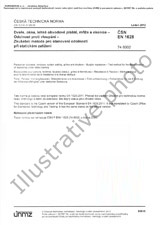We need your consent to use the individual data so that you can see information about your interests, among other things. Click "OK" to give your consent.
ČSN EN 50289-1-2 (347819)
Communication cables - Specifications for test methods - Part 1-2: Electrical test methods - DC resistance
STANDARD published on 1.12.2001
The information about the standard:
Designation standards: ČSN EN 50289-1-2
Classification mark: 347819
Catalog number: 63557
Publication date standards: 1.12.2001
SKU: NS-154426
The number of pages: 8
Approximate weight : 24 g (0.05 lbs)
Country: Czech technical standard
Category: Technical standards ČSN
The category - similar standards:
Annotation of standard text ČSN EN 50289-1-2 (347819):
Norma specifikuje zkušební metody pro stanovení charakteristik stejnosměrné rezistance jader kabelů používaných v analogových a digitálních komunikačních systémech. Tyto charakteristiky jsou popsány rezistancí jádra, rezistancí smyčky a nerovnováhou rezistance. Podrobně je uvedena zkušební metoda, co se týká zkušebního zařízení, zkušebního vzorku a postupu zkoušky. Dále je stanoveno vyjádření výsledků zkoušky včetně teplotní korekce a jsou uvedeny požadavky na obsah protokolu o zkoušce.
These changes apply to this standard:
Komunikační kabely - Specifikace zkušebních metod - Část 1-2: Elektrické zkušební metody - Stejnosměrná rezistance.
Change published on 1.10.2023
Selected format:Show all technical information.
Preview of the standard ČSN EN 50289-1-2 (347819)
Similar standards:
1.1.2014
1.1.2014
1.1.2014
1.1.2014
1.1.2014
WITHDRAWN
1.12.2001
We recommend:
Technical standards updating
Do you want to make sure you use only the valid technical standards?
We can offer you a solution which will provide you a monthly overview concerning the updating of standards which you use.
Would you like to know more? Look at this page.




 Cookies
Cookies
